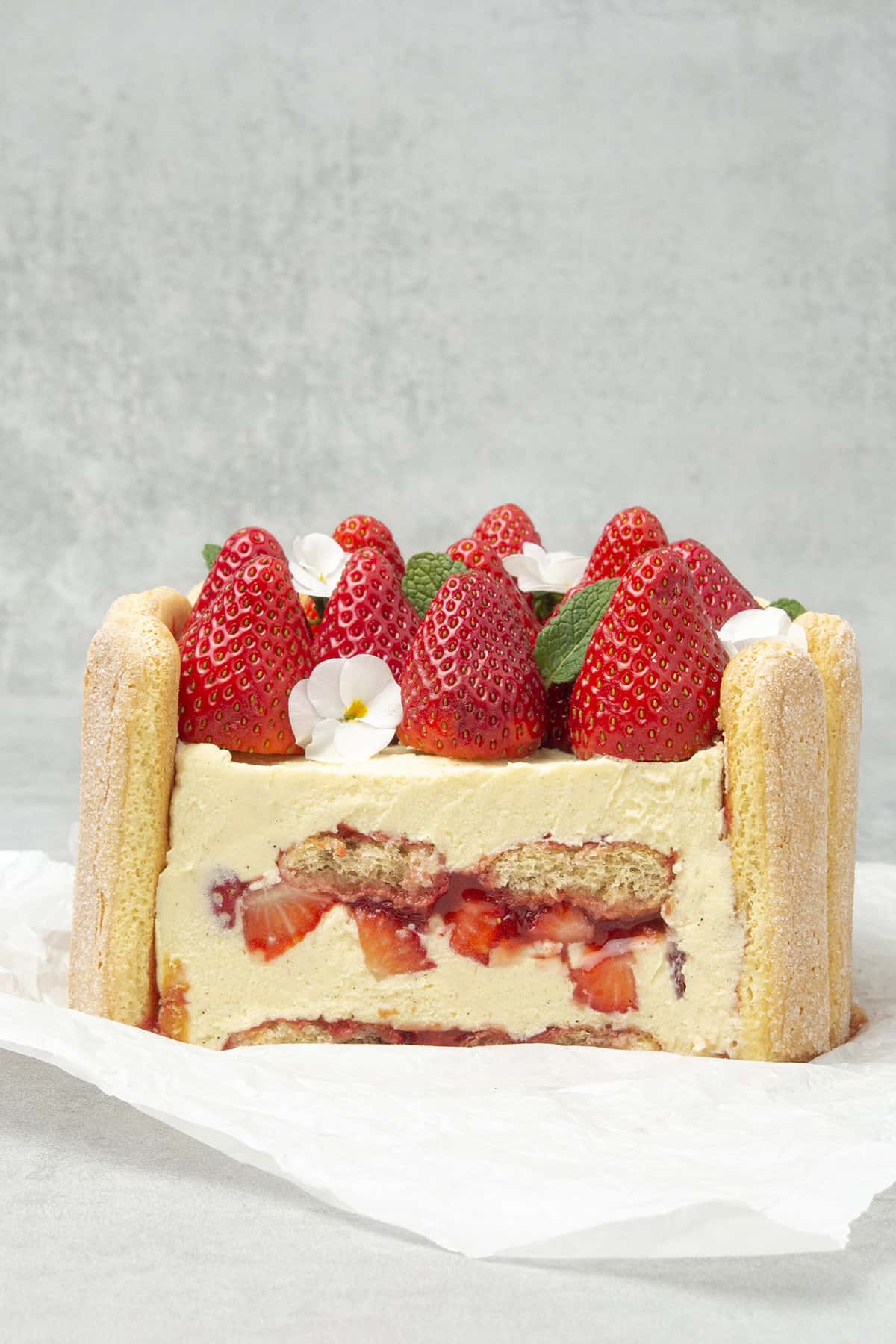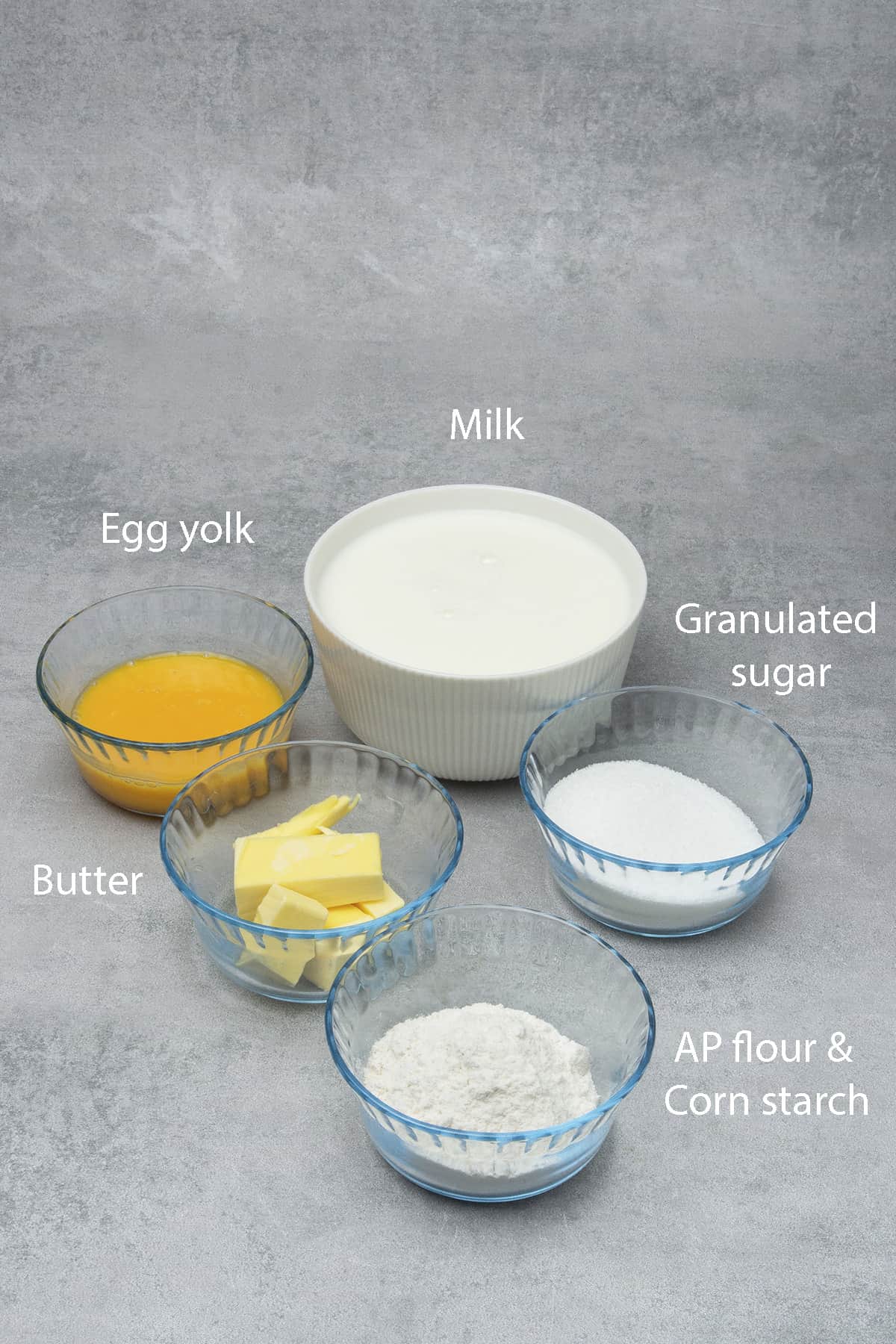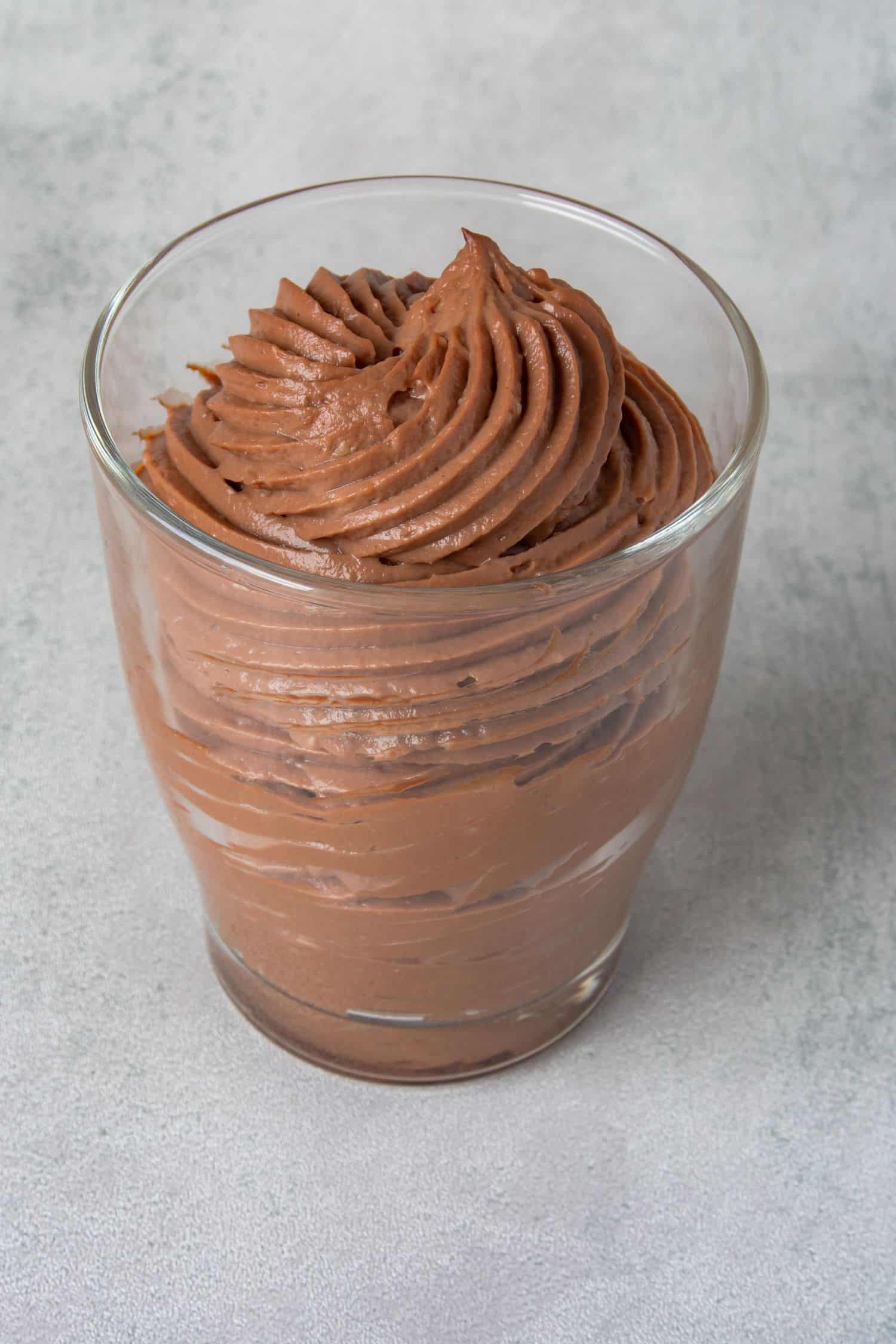A classic crème pâtissière (vanilla pastry cream filling) is a creamy custard that is the perfect filling for cakes, eclairs, donuts, and tarts. It has a silky smooth texture and delicious vanilla flavor. My vanilla pastry cream filling recipe is easy to follow and comes together fast. You will love it!

What is crème pâtissière?
Crème pâtissière is a cooked French custard, also known as vanilla pastry cream filling or crème pât. It is made with milk, butter, egg yolk, sugar, flour, and/or starch, which are cooked on the stove into a thick, rich custard. It is super silky and creamy, melts in your mouth, and is extremely delicious.
Vanilla pastry cream is a key component in desserts such as Mille-feuille, Boston cream pie, or eclairs. It is also the base of other custard-like creams often used in patisseries.
Pastry chefs use crème pâtissière to make other traditional fillings including Crème Mousseline and Crème Diplomat, which has added whipped heavy cream. It is one of the classics, and really worth having in your baking repertoire.

Best vanilla pastry cream recipe
While making homemade French pastry cream sounds complicated, it is extremely easy and quick! There are elements that need your special attention, but I will teach you all my pro tips and tricks. And once you've learned how to make it, you'll be surprised how much you can use it.
It is the perfect filling for so many desserts. No one will believe your cakes and pastries filled with crème pâtissière are all homemade, they'll think you bought them in a fancy French bakery!
Homemade pastry cream has the most luxurious texture and vanilla bean flavor. And you know I never compromise on taste. It's creamy, silky, and rich yet well-balanced in sweetness.
What's more, you can use this easy crème pâtissière in so many ways. Its wonderfully pipeable consistency (with no gelatin) makes it the perfect texture to fill your French pastries and layer cakes. You'll be hooked.

Ingredients

How to make crème pâtissière
Using a hand whisk, whisk the sugar and room-temperature egg yolk together for 1-2 minutes in a large mixing bowl.

Add the vanilla bean paste (or vanilla extract) to the egg mixture, sift in cornstarch and flour, and continue to whisk until you achieve a smooth paste with no lumps.
Meanwhile, heat the milk just to a simmering point in a saucepan over medium heat. I recommend using a good-quality small/medium-sized saucepan with good heat distribution.

Once the flour paste is ready and the milk is simmering (but not boiling), slowly pour the warm milk over the egg yolk mixture in a steady stream. Whisk vigorously to temper the egg yolks rather than scramble them!
Pour the mixture back into the saucepan and cook it over medium heat for a few minutes until it thickens, whisking continuously.
Once you have cooked the vanilla pastry cream for at least 1 minute and it has thickened into a smooth and glossy mixture, remove it from the stove. Feel free to strain your crème pâtissière through a sieve to remove any lumps.

Let it cool slightly for a few minutes, and then use a rubber spatula to mix in the soft room-temperature butter in 3 stages. Softened butter is vital here, as cold butter won't incorporate properly.

How to use pastry cream
You can use pastry cream straight away, or store it in the fridge until needed. Pastry cream contains butter, so it tends to firm up in the fridge. It can also appear slightly lumpy, so give it a few whisks to achieve a smooth, silky, and pipeable consistency.
Make sure it is only a few whisks; do not overbeat it or use a stand mixer, as pastry cream can become runny if overbeaten.
Spread vanilla pastry cream filling onto layers of sponge as a cake filling, it is unbelievably decadent. Transfer it to a piping bag to fill donuts, homemade cream puffs, and fancy desserts like a showstopping croquembouche.
Storing and freezing
Place the homemade crème pâtissière in a large, shallow airtight container and cover the entire surface with plastic wrap to prevent skin from forming on top. You can use it immediately or store it in the fridge for 3-4 days. Do not freeze pastry cream; it ruins the consistency.

Expert tips to make pastry cream
- Make sure you weigh all of your ingredients by the gram with a digital scale and don't measure by volume.
- Ensure the milk is whole (full fat) and the unsalted butter is good quality and high-fat (mine has at least 82%).
- The butter needs to be at room temperature before you begin mixing it into the pastry cream for proper emulsification. Use my tips on how to soften butter, and avoid last-minute microwaving, as melted butter will not work!
- Using egg yolks from farm-fresh, free-range eggs will give your pastry cream a better taste, but a deeper color than cheaper eggs due to the color of the yolks. Use the leftover egg whites to make homemade macarons, which are another famous French dessert and a personal favorite of mine.
- If your pastry cream is too runny, you may not have cooked the mixture for long enough on the stove. Make sure you cook the crème pâtissière for at least a minute after the first boil. This will ensure that the flour is cooked properly, which prevents the pastry cream from having a flour/starch taste.
- If the pastry cream is too firm, there may be too much flour or cornstarch in the mixture. You can loosen up your thick pastry cream by gently folding in some lightly whipped cream.
- If the pastry cream has lumps of flour/starch, it was not properly incorporated with egg yolk in the first stage. Try hand-blending it for a few seconds. If it has other lumps, you perhaps didn't whisk it enough while cooking it. Push the mixture through a fine mesh sieve to get silky smooth pastry cream.

Flavor variations
Pastry cream is really versatile and can be made in many different flavors, not just with vanilla bean paste. Try adding grated lemon zest for a lemon pastry cream or orange or lime zest for a different citrus kick. Spices like cinnamon and nutmeg can add a bit of festive spice during the holiday season.
It is also very easy to turn this vanilla pastry cream filling into a chocolate version. Make the recipe as directed but with half the amount of flour and cornstarch. Melt 100 grams of chocolate, pour the warm pastry cream over the melted chocolate, and fold the two mixtures together.
You may want to consider adjusting the quantity of the sugar, depending on the sweetness of the chocolate you are using in the chocolate pastry cream recipes.
To make coffee pastry cream, swap 50 grams of whole milk for 50 grams of freshly brewed coffee. This tastes especially delicious on chocolate cake!

Ingredient substitutions
Making gluten-free crème pâtissière is super simple! Leave out the flour and replace it 1:1 with cornstarch.
To make this recipe egg-free or dairy-free, you could try one of these egg substitutes and use dairy-free butter and milk. However, classic French recipes like this vanilla pastry cream filling recipe hinge on using eggs and dairy. So replacing them will really affect the quality, texture, and taste of your pastry cream.
If you substitute ingredients, you will also need to adjust the quantities and ratios of the other ingredients in the recipe. Baking is science, so you need to treat each recipe like an equation. Unfortunately, I cannot provide instructions to accommodate every diet.
My list of baking guides will tell you more about common baking ingredients, possible substitutions, and how they may affect your recipes.
Try some of my other desserts
If you enjoyed making this homemade crème pâtissière recipe, try some of my other fillings next.
- Whipped chocolate ganache frosting is a must for any chocolate lover. Spread it onto cakes or add it to chocolate brownies for some double decadence.
- Chantilly cream is another French classic that is super simple, yet elegant. It tastes great on its own with fresh berries, or on cakes, too.
- Raspberry buttercream frosting is fruity and pipes so well, so it is perfect for cupcakes.
- Lemon curd - Creamy, rich, and full of citrus flavor, this tastes delicious on cakes.
- Ermine frosting is another cooked frosting, and you won't believe the texture.
- Caramel filling is perfectly balanced in sweetness and has the best silky texture.
- Mango curd brings some tasty tropical flavor, and it is so much easier to make than you might think!
Have you tried this recipe?
Please leave a 5-star ⭐️⭐️⭐️⭐️⭐️ rating on the recipe card and consider leaving a comment as well!

Classic Crème Pâtissière (Vanilla Pastry Cream Filling)
Equipment
- Digital scale
Ingredients
- 480 g (2 cups) Whole milk 3% fat
- 100 g (½ cups) Granulated sugar
- 80 g (⅓ cups) Egg yolk approx. yolk of 4-5 eggs
- 25 g (3 tablespoons) Corn starch
- 25 g (3 tablespoons) All purpose flour
- 2 teaspoon Vanilla bean paste or vanilla extract
- 55 g (¼ cups) Unsalted butter 82% fat, room temperature soft butter
US customary cup measurement is an indicative figure only. Measure the ingredients with a digital scale by weight (gram). Baking is art but also science which requires precision and accuracy.
Instructions
- In a large enough bowl, using a Hand whisk, whisk together sugar and egg yolk until slightly fluffy for about 1-2 minutes.
- Whisk in the cornstarch, flour, and vanilla until thoroughly incorporated and have a smooth paste.
- Heat milk in a saucepan on medium heat, then remove it as soon as it starts simmering. Make sure it is just simmering and not boiling.
- Pour the warm milk over the egg yolk mixture slowly while whisking vigorously with a Hand whisk. This stage is effectively tempering the egg yolks and the mixture should already start to thicken slightly.
- Pour the mixture back into the saucepan and cook on medium heat for a few minutes until it thickens. Concretely, it is approximately 1 min after the first boil. It might get lumpy first, don't worry, just keep whisking and the cream will get smooth and glossy.
- If in doubt, strain the pastry cream for a lump free, creamy end result.
- Add in room temperature, softened butter chunk by chunk, and mix with a Rubber spatula until completely incorporated. It is worth adding the butter in 3 stages, mixing well after each addition.
- The pastry cream needs to be completely cool before being used for desserts. Place the cream in a shallow bowl and cover the entire surface with plastic wrap to avoid skin forming on top.
- Once cooled, you may need to whisk the pastry cream again to get a smooth texture. Do not overmix it, as it can get runny. Give it a few whisks until smooth. Use it to fill tarts, eclairs, cakes.
- Any leftovers can be used refrigerated in an air-tight container for 2-3 days.
Notes
- Measure your ingredients with a Digital scale for accuracy
- Good quality butter and pure vanilla extract are the heart of making pastry cream. Use high-quality 82% fat content European butter and the best quality vanilla you can access.
- Make sure the butter is at room temperature before you begin. This normally takes around an hour out of the fridge.
- Fresh, farm eggs will provide bright yellow colored pastry cream, while cheaper supermarket eggs will result in a pale cream.
- Use a small/medium sized saucepan with good heat distribution to avoid burning the milk when making pastry cream.
- Let the cream set in the fridge before using. It will further set as it cools into a silky, pipeable consistency.

Sam
hi, can i freeze my eggs yolks in advance (say a week) and defrost them when im ready to make this? or will this affect the consistency and flavour of the final custard?
also i made this recently and it is so good, it pairs really nicely with Swiss meringue buttercream and a vanilla sponge, planning on making it again, but need to prep things differently this time.
Katalin Nagy
Hey, thanks for your feedback, glad you like this recipe. To be completely honest with you, I've never made this recipe with freezed egg yolks. Frozen yolks tend to thicken and become slightly gelatinous. I would whisk them after defrosting and see their texture.
Sam
Hi Katalin,
Thank you for the tip on how frozen egg yolks behave. I'll test them out and see how I go. Ill also let you know if it works or not.